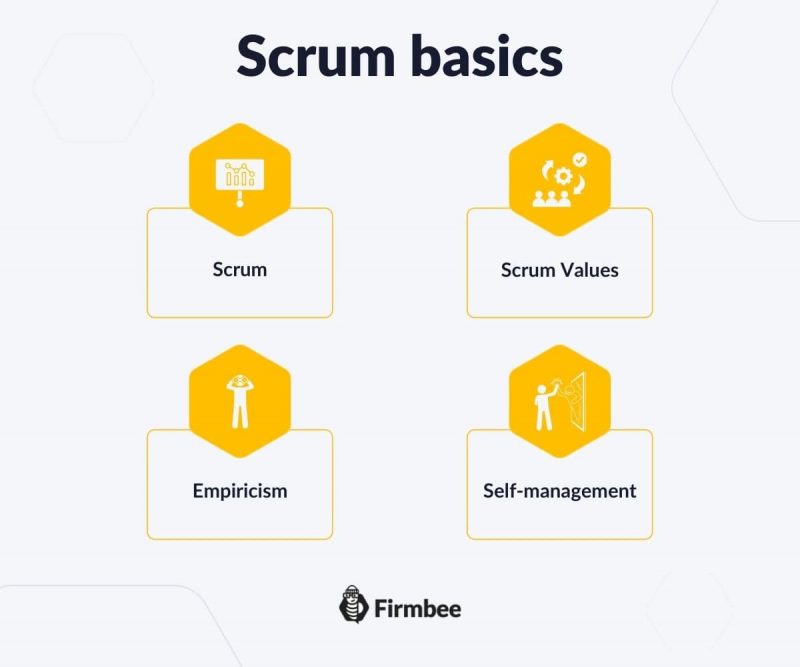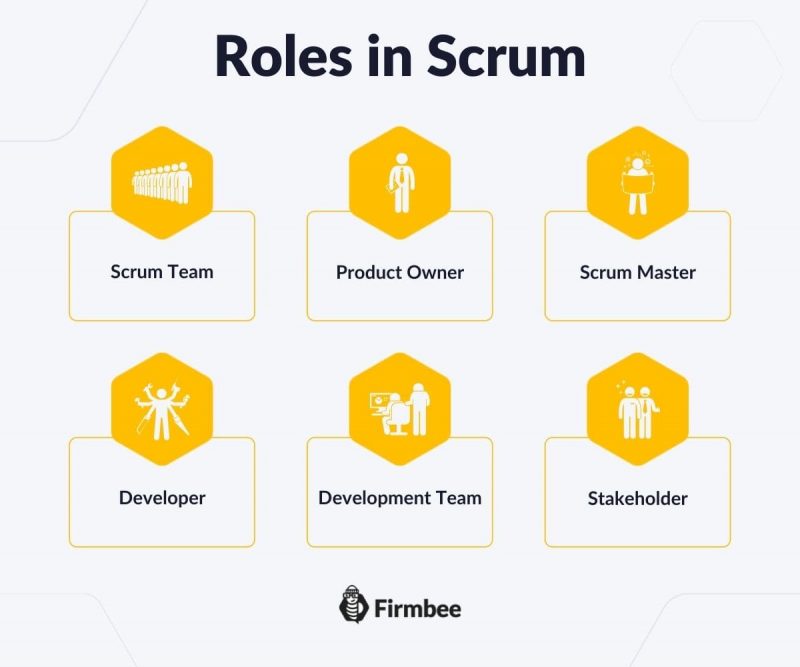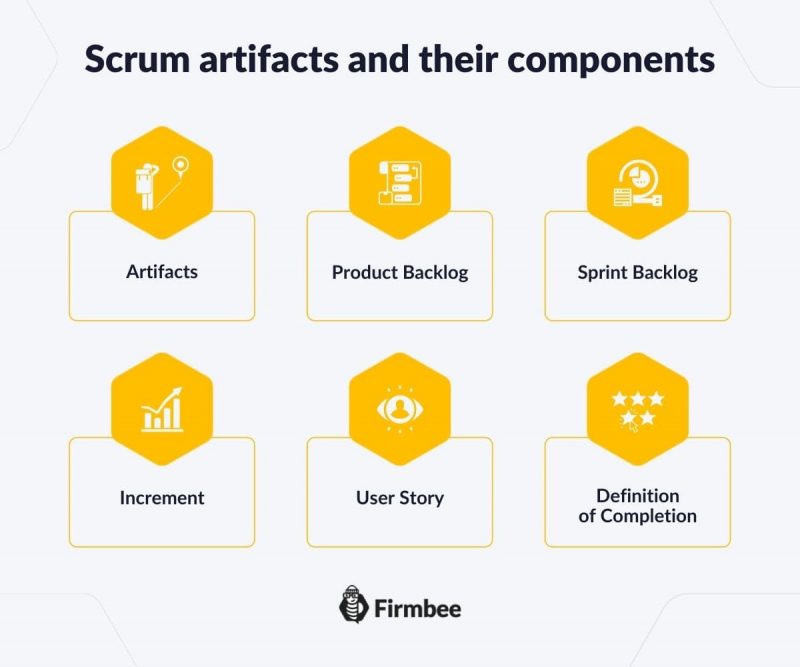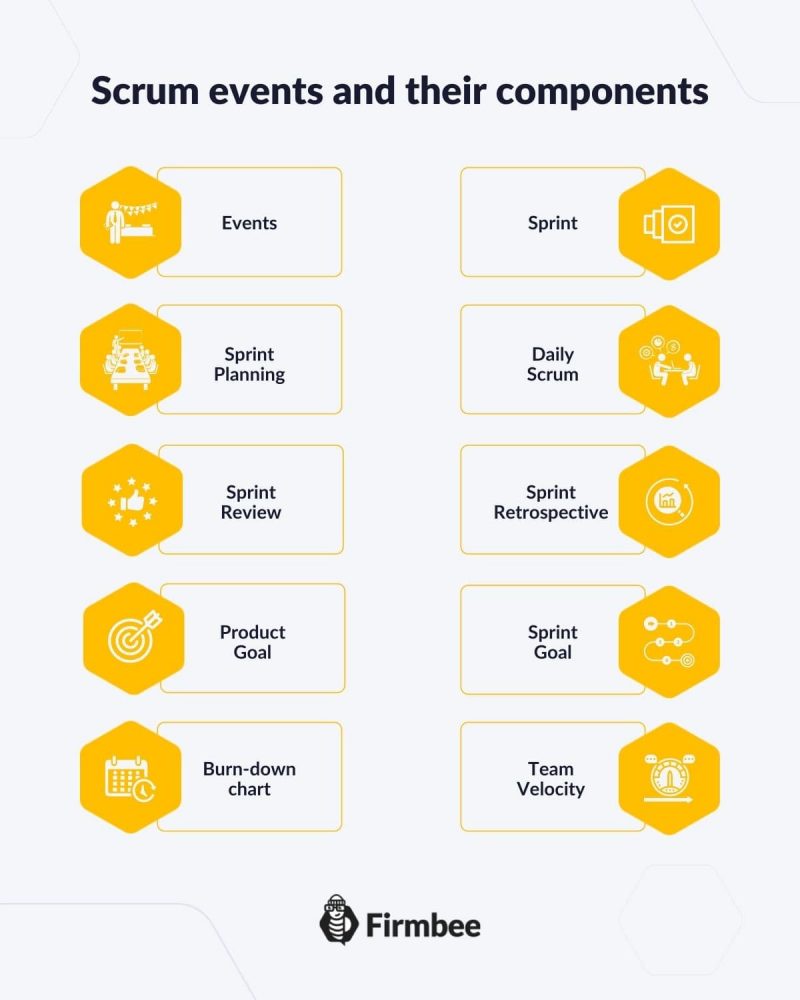Clear and plain language characterizes Scrum terms and jargon and function as the basis for communication and swift team performance during the process of project development. That’s why we gathered the most essential explanations of the key notions of Scrum in the following glossary to introduce you to the topic that’s gained significant importance in modern business management methodology.
Glossary of Scrum Terms – table of contents:
Scrum basics
Scrum – a kind of teamwork management system aimed at developing products and working under a defined scheme. The process breaks down into short Iterations and Sprints – periods of cyclic performance defined precisely below in the glossary. The term “scrum” derives from rugby where it describes certain team formation but its first use as a project management framework method belongs to two Japanese Hirotaka Takeuchi and Ikujiro Nonaka. They wanted to stress the importance of teamwork in the process of project management.

Scrum Values – The 5 values underlying Scrum are:
- Commitment to work
- Focus on goal
- Openness for change
- Respect
- Courage to solve problems
Empiricism – keeping planning and assumptions to a minimum in favor of relying on experience, observation, and experimentation.
Self-management – a feature of Scrum Team which means that its members make their own decisions concerning what tasks to perform, when and how.

Roles in Scrum
Scrum Team – a self-managing team consisting of the Scrum Master, Product Owner, and Developers, also known as the Development Team.
Product Owner – a customer representative inside the Scrum Team. The one responsible for maximizing the value of the product by taking care of the Goal and its implementation by the Development Team.
Scrum Master – a coach and leader of Development Team responsible or proper understanding of Scrum and acting according to its principles.
Developer – each member of Development Team, regardless of professional specialization. A person responsible for co-creating useful Increment in each Sprint.
Development Team– an interdisciplinary group consisting of all Developers involved in creating a Product.
Stakeholder – a person who is not part of Scrum Team and has an interest in creating the best possible Product. Within the Scrum Team, he/she is represented by Product Owner and participates in Sprint Review.

Scrum artifacts and their components
Artifacts – Product Backlog, Sprint Backlog, Increment and their components. They are a reflection of the current state of progress on developing Product in relation to Product Goal, Sprint Goal, and Definition of Completion.
Product Backlog – a structured list of work needed to create a specific Product, i.e., to achieve the Product Goal. Product Owner manages it.
Sprint Backlog – a structured list of work required to deliver the Product functionality defined by the Sprint Goal. It is managed by Development Team.
Increment – complete and valuable work performed by Developers in one Sprint. The sum of all Increments creates Product.
User Story – a description of a partial functionality of a product from the customer’s point of view. It takes the form of “As [user type], I want [what to do?] because [why? why?]”.
Definition of Completion – placed in Product Backlog, a clear and transparent description of the expected state of Product after the completion of the Increment. It describes the work that has been done in the Increment.

Scrum Events and their components
Events – a meeting that relates to the Scrum Team’s work, its planning or feedback. These include Sprint, Sprint Planning, Daily Scrum, Sprint Review, Sprint Retrospective together with their components.
Sprint – a recurring event involving work on a new version of a product. It takes place once or twice a month. It serves as a “container” for other Scrum events and activities.
Sprint Planning – a Scrum Team meeting where all the work to be done in the next Sprint is selected from the Product Backlog. It lasts a maximum of 8 hours.
Daily Scrum – a daily meeting of Development Team where tasks for a given day are planned. It lasts maximum of 15 minutes and always takes place in the same place and time.
Sprint Review – an event summarizing the completed Sprint in terms of Product Goal. For Scrum Team and Stakeholders. Its purpose is to evaluate the Increment and update the Product Backlog. Lasts 4 hours or less.
Sprint Retrospective – an event summarizing the completed Sprint in terms of how the Scrum Team works. Its purpose is to improve Scrum Team performance. Lasts 3 hours or less.
Product Goal – a description of the future Product that Scrum Team is working on. Product Backlog contains the written blueprint with instruction how to attain Product Goal.
Sprint Goal – the work to be done within one Sprint expressed as a business goal. It provides consistency in the work of Development Team.
Burn-down chart – shows the amount of work scheduled in Sprint or Product Backlog in relation to the time remaining to complete it.
Team Velocity – an indicator to determine how much of the Product Backlog has become Incremental during one Sprint.

Read also:How to tackle major issues in project management
If you like our content, join our busy bees community on Facebook, Twitter and Linkedin.
Author: Caroline Becker
As a Project Manager, Caroline is an expert in finding new methods to design the best workflows and optimize processes. Her organizational skills and ability to work under time pressure make her the best person to turn complicated projects into reality.
Scrum Guide:
- Glossary of basic terms, roles and notions
- What is Scrum?
- Scrum values
- How to implement Scrum in your company?
- Scrum Team - what is it and how does it work?
- Who is a Product Owner?
- The most common mistakes of Product Owner
- Who is the Scrum Master?
- Characteristics of a good Scrum Master
- The most common mistakes of Scrum Master
- What statistics and metrics should the Scrum Master track?
- Cooperation between Product Owner and Scrum Master
- Development Team in Scrum
- The most common mistakes of Developers
- Scrum artifacts
- Scaling Scrum
- Sprint Backlog
- What is the Product Backlog?
- What are User Stories?
- Creating the best User Story with INVEST
- The most common User Story mistakes
- User Story Acceptance Criteria
- Estimation and Story Points in Scrum
- Planning Poker
- Team Estimation Game
- Defining Increment
- Scrum events
- What is Sprint in Scrum?
- Scrum Team Commitments - Product Goal, Sprint Goal and Definition of Completion
- What is a Burndown Chart?
- How to create and interpret a burndown chart?
- Advantages and disadvantages of the burndown chart
- Kanban boards in Scrum and Scrumban
- Velocity in Scrum - Speed of the Development Team
- Daily Scrum
- Sprint Planning
- Sprint Review
- What is a Sprint Retrospective?
- Common mistakes during a Sprint Retrospective
- Product Backlog nurturing


















